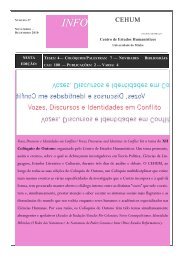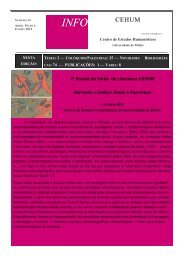Diacritica 25-2_Filosofia.indb - cehum - Universidade do Minho
Diacritica 25-2_Filosofia.indb - cehum - Universidade do Minho
Diacritica 25-2_Filosofia.indb - cehum - Universidade do Minho
You also want an ePaper? Increase the reach of your titles
YUMPU automatically turns print PDFs into web optimized ePapers that Google loves.
JUSTICE, RIGHTS AND THE NON-IDENTITY PROBLEM<br />
According to the notion of harm (II) and (III) in Non-Identity cases<br />
no harm can be <strong>do</strong>ne. Th e diachronic notion (II) of harm presupposes the<br />
existence of the harmed person at time t 1 because we have to compare the<br />
well being of that person at t 1 with the level of well being at t 2 . Th is condition<br />
is not fulfi lled in Non-Identity cases. At t 1 the person is not alive.<br />
According to the subjunctive notion of harm (III) a person must be worse<br />
off due to our action (inaction) at t 2 compared with her level of well being<br />
at t 2 in case of our inaction (action). Because our action (inaction) is a necessary<br />
condition for the existence of that person we cannot compare their<br />
diff erent levels of well being at t 2 .<br />
Unlike in (II) and (III) the threshold notion of harm is independent of<br />
the identity of future people. Any act that causes people to fall below a specifi<br />
ed threshold harms a person and therefore is wrong. Th us, the threshold<br />
notion of harm can explain in Non-Identity cases – in same and diff erent<br />
number choices – why an action is wrong.<br />
Consider once again Parfi t’s Depletion example. Th e threshold notion<br />
of harm can give us an explanation as to why we think that the depletion<br />
of resources is wrong. If the depletion of resources causes the quality of life<br />
of future people to fall below a specifi ed threshold our action harms this<br />
people. Th e same is true for the child of the 14-year old girl. If the 14-year<br />
old mother is not able to ensure her child a decent minimum it is wrong to<br />
conceive a child that early.<br />
Th ere are diff erent objections to the threshold notion of harm. First<br />
it can be stated, that the threshold notion of harm is both, too wide and too<br />
narrow. Too wide, because according to the threshold conception, in some<br />
cases it follows harm is <strong>do</strong>ne where clearly no harm is <strong>do</strong>ne. Too narrow,<br />
because the threshold conception is not able to cover all cases of which we<br />
normally state that a person is harmed (apud Meyer, 2005, 52-53).<br />
Consider the following example:<br />
Suppose a <strong>do</strong>ctor has two courses of action: either to let a patient die or to<br />
intervene and improve his condition without bringing him above the threshold<br />
because the treatment requires a deforming medical intervention (Meyer,<br />
2005: 52). [2]<br />
Because it is not plausible to claim that the <strong>do</strong>ctor acts morally wrong in<br />
treating the patient the threshold conception is too wide. Meyer gives two<br />
2 My translation<br />
<strong>Diacritica</strong> <strong>25</strong>-2_<strong>Filosofia</strong>.<strong>indb</strong> 69 05-01-2012 09:38:21<br />
69



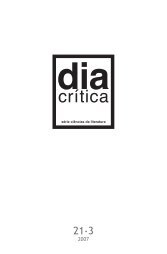

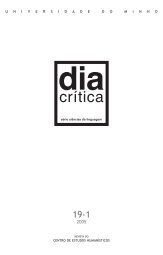



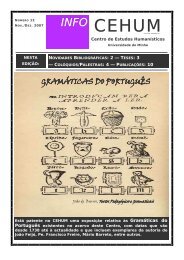

![Programa [pdf] - cehum - Universidade do Minho](https://img.yumpu.com/17305425/1/190x135/programa-pdf-cehum-universidade-do-minho.jpg?quality=85)


